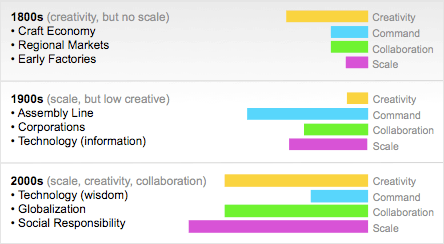As part of our Influencing Strategy by Design course, Tom Chi and I walk through some global trends that provide designers with an opportunity for leadership roles. Specifically Tom illustrates the transition from the 1800s craft economy to the 2000s creative economy.
In the craft economy of the 1800s, regional markets were filled with individual or family-based craftspeople like blacksmiths or potters. These professions required creativity, were small size (no scale), and did not need a lot of collaboration to get products made.
In the industrial economy of the 1900s, small craftsmen gave way to large factories and the need for tight command and control grew as scale increased. Lots of coordination was required to develop consistent products within the assembly lines popping up across developed nations. As a result, the need for creativity was limited to fewer people. Most workers had a defined role in the system and needed to be reliable above all else.
In the economy of the 2000s, creativity is once again a key driver of value as command and control structures can no longer manage the full set of information and decisions required to operate at a global scale. This creates a need for “smart nodes” across the enterprise that can collaboratively lead aspects of the business. These leadership positions are enabled through access to large amounts of data and technology. Creativity is required to make use of this information and set of tools to advance the goals of the organization.

Harvard Business Review recently echoed this sentiment in an article by Rosabeth Moss Kanter titled Transforming Giants: “Employees once acted mainly according to rules and decisions handed down to them, but they now draw heavily on their shared understanding of mission and on a set of tools available everywhere at once. This shift … is now happening with dramatic effects.”
The importance of creative thinking and “smart nodes” within large organizations plays to the strengths of designers who are adept at recognizing patterns, synthesizing information, and communicating it through visual means. In other words, it creates an opportunity for designers to lead.